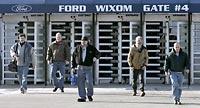Ford to cut up to 30,000 jobs

DEARBORN, Mich. — Two weeks after he became Ford's president of the Americas in October, Mark Fields assembled a team to study the company's brands. He told its members not to report back until they knew what Ford, Lincoln and Mercury stood for.
"It sets up everything in the business. If you don't understand who you are, you can't expect your customers to understand you," Fields said Monday.
With that action, Ford's latest North American restructuring was born. The plan, announced Monday, calls for cutting up to 30,000 jobs and closing 14 plants by 2012 in an effort to bring Ford's North American division to profitability by 2008.
"That's not a prediction. That's a promise," Fields said of Ford's profit goals.
Ford shares rose on the news, indicating some investors were pleased with the long-awaited announcement. The stock gained 42 cents, or 5.3 percent, to close at $8.32 Monday.
Ultimately, 50 people were working in 10 teams on the restructuring, Fields said. It took them 60 days to devise a plan that was presented last month to Chairman and CEO Bill Ford and the company's board.
The team's headquarters was a windowless conference room next to a long row of engineers' cubicles. The walls of the conference room are papered with charts, goals and timetables. One of Fields' favorite slogans on the wall: "Culture eats strategy for breakfast."
"You can have the best plan in the world, and if the culture isn't going to let it happen, it's going to die on the vine," Fields said.
Fields said he tried this strategy once before, at Mazda, which he led from 2000 to 2002. In that case, his team took seven months to develop a turnaround plan, but Ford's North American losses called for more urgent action, he said.
Mazda is widely viewed as a success story. In 2005, Ford's share of Mazda profits was $255 million, more than double the $118 million of 2004, and Mazda is expecting to report record profits for the fiscal year that ends in March. Ford owns a 33 percent share in the Japanese automaker.
Fields said he encountered some initial skepticism at Ford, but employees realize the company needs to take significant action to stem its billion-dollar losses.
Earlier Monday, Ford reported earnings of $2 billion in 2005, down 42 percent from 2004 profit of $3.5 billion. It was the third straight year the automaker has reported a profit, but gains in Europe, Asia and elsewhere were offset by a loss of $1.6 billion in North American operations. Ford also said it would no longer be providing earnings guidance beginning in 2006 so it can focus on long-term goals instead of short-term gains.
Some analysts said the plan — dubbed "Way Forward" — was short on details.
"It's a step forward in the culture of Ford. Whether it translates into increased profits remains to be seen," said Brian Johnson, an auto analyst with Sanford Bernstein.
The cuts represent up to 25 percent of Ford's North American work force of 122,000 people. Ford has about 87,000 hourly workers and 35,000 salaried workers. In addition, the company plans to cut 12 percent of its corporate officers in the next two months.
Ford's St. Louis plant will be the first plant idled, in the first quarter of this year. A plant in Atlanta will close at the end of this year, and a plant in Wixom, Mich., will close in the second quarter of 2007, Fields said.
Other plants to be idled and eventually closed through 2008 are Batavia Transmission in Ohio and Windsor Casting in Ontario. Ford will choose two more plants to be idled later this year. The company also will reduce production to one shift at its St. Thomas assembly plant in Ontario.
Ford plans to build one plant in North America as part of the plan, but Fields wouldn't say where it will be located. He would say only that the plant must be a low-cost operation. He also said the company expects to achieve $6 billion in material cost savings by 2010.
Under the company's existing contract with the United Auto Workers, workers at the idled plants will continue to get most of their pay and benefits until a new contract is negotiated next year.
UAW President Ron Gettelfinger and Vice President Gerald Bantom called the plan "extremely disappointing" and said it will make 2007 contract negotiations much more difficult.
"The impacted hourly and salaried workers find themselves facing uncertain futures because of senior management's failure to halt Ford's sliding market share," they said in a statement. "The announcement has further left a cloud hanging over the entire work force because of pending future announcements of additional facilities to be closed at some point in the future."
Alan Hallman, mayor of Hapeville, Ga., where the Atlanta Assembly Plant is located, called the news "a setback for the state."
The plant, which makes the Taurus, has about 2,000 employees. Hallman said it accounts for 9 percent of the small city's budget.
"We've got hundreds of man-hours and thousands of dollars invested on various plans to keep them here. The fact that they've elected to idle the plant is very disappointing," he said.
In Wixom, 18-year worker James Crawford said he is too young to retire and might not have enough seniority to get hired at another plant.
"This really hits me hard," said the 48-year-old car painter, who listened to the announcement on the radio in a white Ford Probe parked across the street from the plant. "It looks like I'm starting over."
Ford and its larger rival, General Motors, have been hurt by falling sales of profitable sport-utility vehicles, growing health-care and materials costs and restrictive labor contracts. GM announced a similar restructuring plan in November that will shave its work force by 30,000 and close 12 North American facilities.

